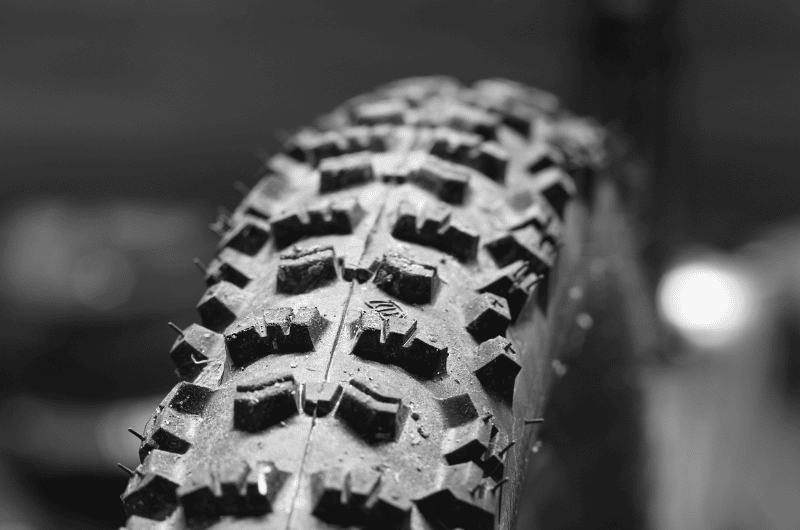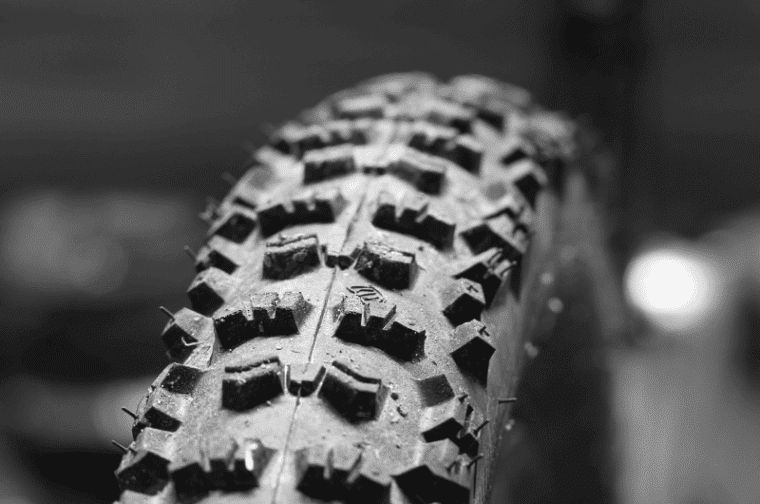Bicycle tyres (or tires) are one of the most important parts of your ride. They are the only bit that touches the surface you travel along. They provide grip, comfort, puncture-resistance, and a certainty that you should be able to stay the right way up.
How Often Do Bike Tyres Need to Be Replaced?
Tyres need to be a reliable and hard-wearing component. Along with most other forms of transportation, the part which makes contact with the road surface is going to need to be replaced. An average bicycle tyre ridden on smooth surfaces, and kept correctly inflated, should last around 3,000 miles.
Cycling is a very sustainable form of transportation, and even though parts like tyres need replacing there is a solid programme of recycling them, which we’ve looked at here. I once owned a pair of slides which had a sole made out of old bicycle tyres.
The main reason your bicycle tyre will need replacing is simple wear and tear. The tyre is fairly simple in design. Going from the outside in you have a rubber compound tread which usually covers an anti-puncture strip and/or cut-protection layer, then a casing. Rigidity and strength comes in the form of a sidewall and bead running along the edges of the tyre.
Although there is no minimum tread depth required, or mandatory annual inspection of the bicycle, there are still lots of choices once you recognise they need replacing. At least you only have to buy two at most. Other moving parts like chains need replacing too – which we examine here.
Any consumer product which wears down will spawn a huge market for replacements. Think about car tyres. The choices on offer feel like walking into a minefield. Comfort, weight and reliability have introduced the clincher tyre, the tubeless, and the tubular tyre to the cycling world. Each does different things – we look at the tubeless tyre here with many riders now swapping from clinchers to tubeless.
How Many Years Do Bike Tyres Last?
With a limit of around 3,000 miles, the length of time that a tyre will last depends on how often you ride and under what load. Even the weather conditions play a part. There is no one definitive answer. Even if you don’t ride regularly, they may need replacing every three years as they do degrade.
How Do You Know if a Bike Tyre Needs to Be Replaced?
Most bike tyres give visual clues of the need to be replaced before a dangerous blow, out or series of punctures. They should carry out their duties with the minimum of fuss provided they are looked after. It is vital that you check your tyres regularly for signs of wear, tear, and degradation.
One of the most difficult to identify is the damaged sidewall. This part does not make contact with the road but provides the strength to support the bike and rider’s weight. It is most frequently damaged when the wheel itself actually makes contact with the surface being travelled on.
Even if you keep your tyres inflated to the correct pressure, you sometimes cannot avoid this contact. For most of us it will be when we slam into a pothole in the road. The sidewall could be torn after the impact and this could expose the inner tube, even if you don’t have a puncture.
At the very least it will compromise the strength of the tyre and further damage is almost inevitable. It is a good idea to stop and inspect the sidewall to see if the inner tube is peeking out. You should probably have your wheels checked by a professional at the same time.
An easier guide is provided by many manufacturers. The tread wear indicator supplied on the surface of the tyre itself gives you warning and will prepare you for the time when the tyre needs replacing.
Not all tyres come with this replacement, but if they do, then these should be checked regularly. Some have circular ‘tap-holes’ in the central area of the tyre. When the tyre is so worn that they disappear, a replacement is due.

Any knobbles on the tread will wear down although the speed with which they do so depends upon how you ride. Mountain bikes and gravel bikes tyres are subjected to more harsh treatment, and you need to buy wisely with longevity in mind if you ride on trails and rough surfaces regularly.
Hybrid bikes and road bikes usually just have simple lines and tracks to dissipate water and should not wear down so quickly. Tread patterns are not vital for road cycling and commuting. However, you may notice a series of cuts and nicks to the tread. Your cut-protection and anti-puncture strip has done it’s work, but too many will put the tyre at risk and replacing is a sensible decision.
A rear tyre takes more strain than the front and swapping them around can prolong the life of both – albeit temporarily and when done safely. Try to avoid skidding the rear tyre as this may wear down a specific part of it. Even though the rest of it is intact, the wear could be dangerous enough to warrant a replacement.
Other signs of the need to replace bicycle tyres could be if you get repeated flat tyres – especially from small flints, stones and glass – the tread will have worn down sufficiently at this point so as to offer no protection. Obviously if you see any of the protective layer or casing, replacement is overdue. These usually look like a series of straight metallic chords.
Bike Tyre Cost
The average discerning cyclist does not need to spend a fortune on replacement tyres. Although it is true that models fitted to a new bicycle are not necessarily the coolest – books could be written on tan coloured sidewalls versus black coloured sidewalls – most commuters and urban users should focus on a combination of wear and comfort.
Replacing tyres is a simple DIY job requiring only three plastic tyre levers, a spanner to remove the wheel, and a bicycle pump. Your local bike shop will stock all of these. Do NOT use the ends of dining table cutlery to unseat your old tyre or fit your new one. Do NOT be tempted to inflate your tyres at a petrol / gas station. The high pressure machines there are designed for vehicle tyres only.
How Much Does it Cost to Replace a Bicycle Tyre?
You can expect to pay anything from £8/$ 10 up to £50/$ 60 for tyres before you get into the specialist areas of tyres designed for speed and specific cycling disciplines. £20/$ 24 will get you a reliable and comfortable set of shoes for your bicycle.
Remember that keeping them regularly inflated to the correct pressure is key to a long life and optimum riding conditions. Inspect them at lest once a week for nicks, cuts and signs of wear.
The post Bike Tyre Cost: How Much Cost to Replace a Bicycle Tyre? appeared first on Discerning Cyclist.
